
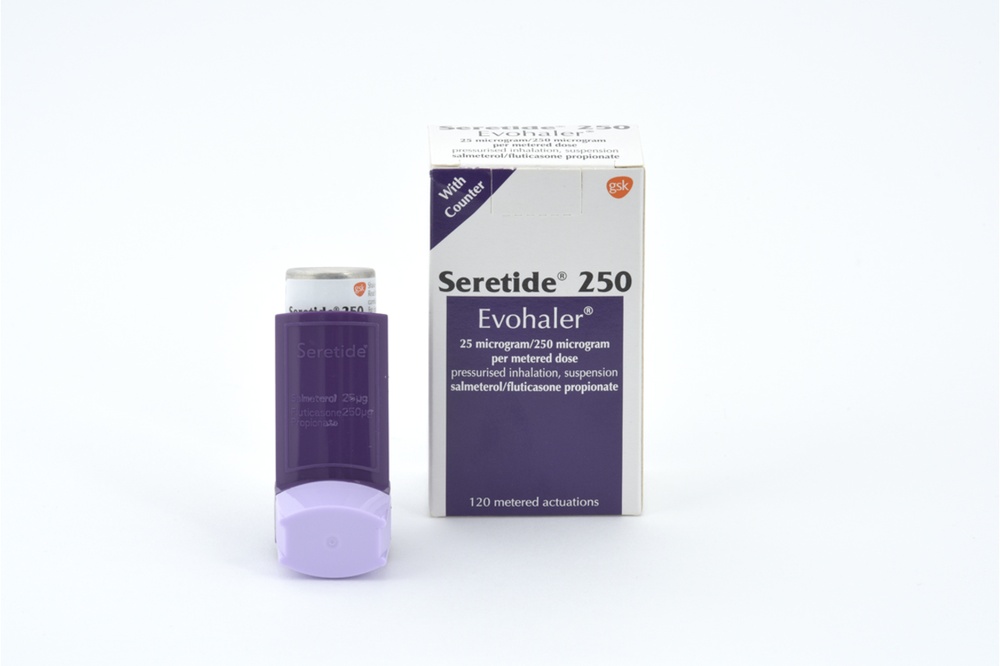
Seretide 250

Ask a doctor about a prescription for Seretide 250

How to use Seretide 250
Leaflet accompanying the packaging: patient information
Seretide 50, (50 g + 25 g)/inhalation dose, inhalation aerosol, suspension
Seretide 125, (125 g + 25 g)/inhalation dose, inhalation aerosol, suspension
Seretide 250, (250 g + 25 g)/inhalation dose, inhalation aerosol, suspension
Fluticasone propionate + Salmeterol
Read the leaflet carefully before using the medicine, as it contains important information for the patient.
- Keep this leaflet, you may need to read it again.
- In case of any doubts, consult a doctor or pharmacist.
- This medicine has been prescribed specifically for you. Do not pass it on to others. The medicine may harm another person, even if their symptoms are the same.
- If the patient experiences any side effects, including any side effects not listed in this leaflet, they should tell their doctor or pharmacist. See section 4.
Table of contents of the leaflet:
- 1. What is Seretide and what is it used for
- 2. Important information before using Seretide
- 3. How to use Seretide
- 4. Possible side effects
- 5. How to store Seretide
- 6. Package contents and other information
1. What is Seretide and what is it used for
Seretide contains two active substances: salmeterol and fluticasone propionate.
- Salmeterol is a long-acting bronchodilator. Bronchodilators help maintain airway patency. This facilitates airflow to and from the lungs. The effect lasts for at least 12 hours.
- Fluticasone propionate is a corticosteroid that reduces swelling and irritation of the lungs.
The doctor has prescribed this medicine to the patient to prevent breathing disorders occurring in asthma. To ensure proper control of asthma, Seretide must be used every day, as recommended by the doctor.
Seretide prevents the occurrence of shortness of breath and wheezing in the airways. However, it should not be used to control sudden attacks of shortness of breath or wheezing in the airways. If such an attack occurs, it is necessary to use a rapidly acting bronchodilator, such as salbutamol, immediately. The patient should always have such a medicine with them.
Always carry a rapidly acting bronchodilator with you.
2. Important information before using Seretide
When not to use Seretide
- if the patient is allergic to salmeterol, fluticasone propionate, or norflurane (HFA 134a), an excipient of the medicine.
Warnings and precautions
The patient should discuss with their doctor before starting to use Seretide if they have:
- heart disease, including irregular or rapid heartbeat,
- hyperthyroidism,
- high blood pressure,
- diabetes (Seretide may increase blood glucose levels),
- low potassium levels in the blood,
- tuberculosis currently being treated or a history of tuberculosis, or other lung infections.
If the patient experiences blurred vision or other vision disturbances, they should contact their doctor.
Seretide and other medicines
The patient should tell their doctor about all medicines they are currently taking or have recently taken, as well as any medicines they plan to take, including asthma medicines and over-the-counter medicines. Seretide should not be used with certain medicines. Before starting to use Seretide, the patient should inform their doctor about taking the following medicines:
- beta-blockers (e.g., atenolol, propranolol, and sotalol). Beta-blockers are most commonly used to treat high blood pressure or other heart diseases.
- medicines used to treat infections (e.g., ketoconazole, itraconazole, and erythromycin), including some medicines used to treat HIV (e.g., ritonavir, cobicistat-containing products). Some of these medicines may increase the levels of fluticasone propionate or salmeterol in the body. This may increase the risk of side effects, including irregular heartbeat or worsening of existing side effects. The doctor may want to closely monitor the patient's condition while taking such medicines.
- corticosteroids (orally or by injection). If the patient has recently taken such medicines, it may increase the risk of adrenal gland disorders.
- diuretics used to treat high blood pressure.
- other bronchodilators (such as salbutamol).
- medicines containing xanthine derivatives, often used to treat asthma.
Pregnancy and breastfeeding
If the patient is pregnant or breastfeeding, thinks they may be pregnant, or plans to have a child, they should consult their doctor before using this medicine. The doctor will assess whether the patient can use Seretide during this period.
Driving and using machines
It is unlikely that Seretide will affect the patient's ability to drive or use machines.
3. How to use Seretide
Seretide should always be used as recommended by the doctor. In case of doubts, the patient should consult their doctor or pharmacist.
- Seretide should be used every day, unless the doctor recommends otherwise. The patient should not take a higher dose than recommended. In case of doubts, the patient should consult their doctor or pharmacist.
- The patient should not stop using Seretide or reduce the dose without consulting their doctor.
- Seretide should be inhaled into the lungs through the mouth.
Adults and adolescents from 12 years of age:
- Seretide 50: two inhalations twice a day.
- Seretide 125: two inhalations twice a day.
- Seretide 250: two inhalations twice a day.
Children from 4 to 12 years of age:
- Seretide 50: two inhalations twice a day.
- Seretide is not recommended for use in children under 4 years of age.
If the patient's asthma symptoms are well-controlled while using Seretide twice a day, the doctor may recommend reducing the frequency of Seretide use to once a day. The dose can be given:
- once a day, in the evening, if the patient's symptoms occur at night,
- once a day, in the morning, if the patient's symptoms occur during the day.
It is very important that the doctor instructs the patient on how much and how often to use Seretide. If the patient is using Seretide for asthma, the doctor will regularly check the patient's symptoms.
In case of worsening asthma symptoms or loss of asthma control, the patient should
contact their doctor immediately.The patient may experience worsening wheezing, more frequent chest tightness, or may need to use more of a rapidly acting, inhaled bronchodilator. In such a situation, the patient should continue using Seretide, but not increase the number of inhalations. The patient's symptoms may worsen, and their condition may deteriorate. The patient should contact their doctor, as they may need additional treatment.
Instructions for using the inhaler
- The doctor, nurse, or pharmacist should instruct the patient on how to use the inhaler properly. They should periodically check that the patient is using the inhaler correctly. Using Seretide contrary to the doctor's recommendations or improper use of the inhaler may cause the medicine to not produce the expected improvement in asthma.
- The medicine is in a pressurized container, in a plastic casing with a mouthpiece.
- On the back of the inhaler, there is a dose counter that shows how many doses of the medicine are left in the inhaler. After each press of the container, a dose of the medicine is released, and the counter decreases by one.
- The patient should be careful not to drop the inhaler, as this may cause the counter to decrease.
Checking the inhaler
- 1. Before the first use, the patient should check if the inhaler is working. The patient should remove the cap from the mouthpiece of the inhaler by gently pressing the sides of the cap with their thumb and index finger.
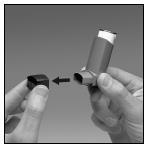
- 2. To ensure the inhaler is working, the patient should shake the inhaler vigorously, point the mouthpiece away from them, and release a dose of the medicine into the air; the patient should repeat this process, shaking the inhaler before releasing each dose, until the counter shows 120. If the inhaler has not been used for a week or longer, the patient should remove the cap from the mouthpiece, shake the inhaler vigorously, and release two doses of the medicine into the air.
Using the inhaler
It is essential to start slow breathing, as slow as possible, before using the inhaler.
- 1. The patient should inhale while standing or sitting.
- 2. The patient should remove the cap from the mouthpiece of the inhaler (as shown in figure 1). The patient should check the mouthpiece outside and inside to ensure it is clean and free of foreign objects.
- 3. The patient should shake the inhaler 4 or 5 times to ensure that any foreign objects are removed and the contents of the inhaler are well mixed.
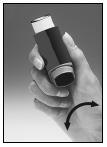
- 4. The patient should hold the inhaler upright with their fingers, with their thumb on the base of the inhaler, below the mouthpiece. The patient should take a deep breath out, as deep as possible.
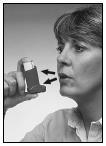
- 5. The patient should put the mouthpiece in their mouth and seal it with their lips. The patient should not bite the mouthpiece.
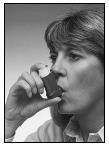
- 6. The patient should start slow and deep breathing. Immediately after starting to breathe in through the mouth, the patient should press the inhaler to release a dose of Seretide, and then continue with slow, deep breathing.
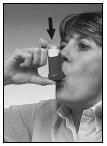
- 7. The patient should hold their breath, remove the inhaler from their mouth, and take their finger off the inhaler base. The patient should hold their breath for a few seconds or as long as it is comfortable, and then breathe out slowly.
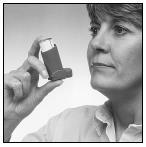
- 8. If the doctor has recommended two inhalations of the medicine, the patient should wait about half a minute before repeating the steps described in points 3-7.
- 9. Rinsing the mouth with water and spitting it out and (or) brushing teeth after each inhalation can help prevent hoarseness and thrush.
- 10. After each inhalation, the patient should always replace the cap on the mouthpiece to prevent dust from entering it. The patient should replace the cap by clicking it into place. If the cap does not click into place, the patient should remove it, turn it upside down, and try to replace it again. The patient should not use too much force.
The patient should not rush through the steps described in points 4, 5, 6, and 7. It is essential to breathe as slowly as possible before each inhalation. To ensure that the inhalation is performed correctly, the patient should initially practice in front of a mirror. The "mist" coming out of the inhaler, mouth, or nose during inhalation indicates incorrect inhalation technique. The patient should repeat the steps starting from point 3.
As with all inhalers, caregivers should ensure that children prescribed Seretide use the inhaler correctly, as described above.
If the patient has difficulty coordinating their breath and inhalation from the inhaler, they may be advised to use an inhaler with a spacer. The doctor, nurse, or pharmacist should instruct the patient on how to use the inhaler with a spacer and how to care for the spacer, and answer any questions the patient may have. If the patient uses a spacer, it is essential not to stop using it without consulting their doctor or nurse. It is also crucial not to change the type of spacer without consulting their doctor. If the patient stops using the spacer or changes its type, the doctor may decide to change the dose of the medicine needed to control asthma symptoms. The patient should always consult their doctor before making any changes to their asthma treatment.
Older children or people with weak hands may find it easier to hold the inhaler with both hands.
The patient should hold the inhaler with two index fingers on top of the inhaler and both thumbs on the bottom, below the mouthpiece.
If the counter shows 020, the patient should remember that the medicine is about to run out. The patient should replace the inhaler with the medicine when the counter shows 000, as the amount of medicine left in the inhaler may not be enough to deliver a full dose. The patient should never try to increase the counter reading, as it cannot be reset.
Cleaning the inhaler
To prevent the inhaler from clogging, the patient should clean it at least once a week.
To clean the inhaler:
- Remove the cap from the mouthpiece.
- Do not remove the metal container from the plastic casing during cleaning or at any other time.
- Clean the mouthpiece inside and outside and the plastic casing outside with a dry cloth or tissue.
- Replace the cap on the mouthpiece. When the cap is properly replaced, it will click into place. If the cap does not click into place, the patient should remove it, turn it upside down, and try to replace it again. The patient should not use too much force.
The patient should not immerse the metal container in water.
Using a higher dose of Seretide than recommended
It is essential to use the inhaler as instructed. If the patient accidentally uses a higher dose than recommended, they should tell their doctor or pharmacist.
The patient may experience: rapid heartbeat, tremors, dizziness, headache, weakness, and joint pain.
If the patient uses higher doses for an extended period, they should consult their doctor or pharmacist for advice, as high doses of Seretide may cause a decrease in the production of steroid hormones by the adrenal glands.
Missing a dose of Seretide
The patient should not take a double dose to make up for a missed dose. The patient should take the next dose at the scheduled time.
Stopping the use of Seretide
It is very important to take Seretide every day as recommended by the doctor. The patient should take the medicine until the doctor recommends stopping it.The patient should not suddenly stop taking Seretide or reduce the dose,as the symptoms of the disease may worsen.
Additionally, sudden stopping or reduction of Seretide may (very rarely) cause adrenal gland disorders (adrenal insufficiency), which can sometimes cause side effects.
These side effects may include:
- abdominal pain,
- fatigue and loss of appetite, nausea,
- vomiting and diarrhea,
- weight loss,
- headache and drowsiness,
- low blood sugar,
- low blood pressure and seizures. When the body is under stress, such as from fever, injury (such as a car accident), infection, or surgery, adrenal insufficiency may worsen, and any of the above side effects may occur.
If the patient experiences any of these side effects, they should tell their doctor or pharmacist. To prevent these symptoms, the doctor may prescribe additional corticosteroids in tablet form (e.g., prednisolone).
In case of any further doubts about using this medicine, the patient should consult their doctor, nurse, or pharmacist.
4. Possible side effects
Like all medicines, Seretide can cause side effects, although not everybody gets them.
To minimize the risk of side effects, the doctor will recommend the lowest dose of Seretide that controls asthma.
Allergic reactions: The patient may experience sudden breathing difficulties immediately
after using Seretide.The patient may experience worsening wheezing, coughing, or shortness of breath, as well as itching, rash (hives), and swelling (usually of the face, lips, tongue, or throat). The patient may also experience a very rapid heartbeat, weakness, dizziness (which can lead to falls or loss of consciousness). If the patient experiences any of these symptoms soon after using Seretide, they should stop using Seretide and contact their doctor immediately.Allergic reactions to Seretide are uncommon (they may occur in 1 to 10 out of 1000 patients taking the medicine).
Other side effects:
Very common side effects(may occur in more than 1 in 10 patients):
- Headache - this side effect usually decreases over time while continuing treatment.
- Increased frequency of colds in patients with COPD.
Common side effects(may occur in 1 to 10 out of 100 patients):
- Thrush (painful, creamy-white patches) in the mouth and throat, as well as tongue pain, hoarseness, loss of voice, and throat irritation. Rinsing the mouth with water and spitting it out and (or) brushing teeth after each inhalation can help.
Rinsing the mouth with water and spitting it out and (or) brushing teeth after each inhalation can help prevent hoarseness and thrush. The doctor may recommend an antifungal medicine to treat thrush.
- Pain, swelling of the joints, and muscle pain.
- Muscle cramps.
The following side effects have been reported in patients with chronic obstructive pulmonary disease (COPD):
- Pneumonia (lung infection). The patient should tell their doctor if they experience any of the following symptoms while using Seretide - these may be symptoms of a lung infection: fever or chills, increased mucus production, change in mucus color, worsening cough, or increased breathing difficulties.
- Easier bruising and fractures.
- Sinusitis (feeling of tension and fullness in the nose, cheeks, and behind the eyes, sometimes with a pulsating headache).
- Low potassium levels in the blood (the patient may experience irregular heartbeat, muscle weakness, cramps).
Uncommon side effects(may occur in 1 to 10 out of 1000 patients):
- Increased blood sugar (glucose) levels (hyperglycemia). In patients with diabetes, it may be necessary to monitor blood sugar levels more frequently and adjust the dose of antidiabetic medicines.
- Cataracts (clouding of the lens of the eye).
- Very rapid heartbeat (tachycardia).
- Feeling of trembling and rapid or irregular heartbeat (palpitations) - these symptoms usually are not serious and decrease over time while continuing treatment.
- Atrial fibrillation.
- Ischemic heart disease, which may cause chest pain and shortness of breath.
- Sleep disturbances.
- Restlessness.
- Allergic skin rash.
Rare side effects(may occur in 1 to 10 out of 10,000 patients):
- Wheezing or breathing difficulties worsening immediately after using Seretide.The patient should stop using Seretide, use a rapidly acting, inhaled bronchodilator, and contact their doctor immediately.
- Seretide may disrupt the normal production of steroid hormones by the body, especially when using high doses for an extended period. These symptoms may include:
- growth retardation in children and adolescents,
- decreased bone density,
- glaucoma,
- weight gain,
- moon face (Cushing's syndrome). The doctor will regularly check for these side effects and ensure that the patient is using the lowest dose of Seretide that controls asthma.
- Changes in behavior, such as excessive excitement and irritability (these symptoms occur mainly in children).
- Irregular heartbeat or extra beats (arrhythmias). The patient should inform their doctor, but not stop using Seretide unless the doctor recommends it.
- Fungal infection of the esophagus, which can cause difficulty swallowing.
Side effects with unknown frequency(frequency cannot be estimated from available data):
- Depression or aggression. The occurrence of these side effects is more likely in children.
- Blurred vision.
Reporting side effects
If the patient experiences any side effects, including any side effects not listed in this leaflet, they should tell their doctor or pharmacist. Side effects can be reported directly to the Department of Drug Safety Monitoring, Office for Registration of Medicinal Products, Medical Devices, and Biocidal Products, Al. Jerozolimskie 181C, 02-222 Warsaw, tel.: 22 49-21-301, fax: 22 49-21-309, website: https://smz.ezdrowie.gov.pl
Side effects can also be reported to the marketing authorization holder.
Reporting side effects will help to gather more information on the safety of this medicine.
5. How to store Seretide
- Keep out of the sight and reach of children.
- Do not use Seretide after the expiry date stated on the packaging. The expiry date (EXP) is the last day of the month stated. The batch number is the lot number.
- Store in a temperature not exceeding 30°C. Do not store in a refrigerator or freeze.
- Like most pressurized inhalers, the therapeutic effect of this medicine may decrease when the container is cold.
- The metal container contains a pressurized suspension. Do not expose to temperatures above 50°C, protect from direct sunlight. Do not pierce or burn the container, even if it appears to be empty. Medicines should not be disposed of via wastewater or household waste. The patient should ask their pharmacist how to dispose of medicines they no longer use. This will help protect the environment.
6. Package contents and other information
What Seretide contains
- The active substances of the medicine are: salmeterol and fluticasone propionate. Each metered dose contains 25 micrograms (µg) of salmeterol (as salmeterol xinafoate) and 50, 125, or 250 micrograms (µg) of fluticasone propionate.
- The other ingredient is the propellant: 1,1,1,2-tetrafluoroethane (norflurane, HFA 134a).
This medicine contains fluorinated greenhouse gases.
Each inhaler contains g CO2 equivalent (global warming potential GWP = ).
What Seretide looks like and contents of the pack
- Seretide is supplied in an inhaler containing the medicine as a pressurized suspension for inhalation through the mouth into the lungs.
- The container is a white to off-white suspension for inhalation.
- Packaging:Aluminum container closed with a metering valve, equipped with a plastic actuator with a dose counter, in a cardboard box. One pressurized container contains 120 doses.
Marketing authorization holder and manufacturer
Marketing authorization holder:
GlaxoSmithKline Trading Services Limited
12 Riverwalk
Citywest Business Campus
Dublin 24
D24 YK11
Ireland
Manufacturer:
Glaxo Wellcome Production
Zone Industrielle No. 2
23, rue Lavoisier
27000 Evreux
France
To obtain more detailed information, the patient should contact the representative of the marketing authorization holder:
GSK Services Sp. z o.o.
tel. (22) 576-90-00
{logo of the marketing authorization holder}
Date of last revision of the leaflet:January 2025
- Country of registration
- Active substance
- Prescription requiredYes
- ImporterGlaxo Wellcome Production
- This information is for reference only and does not constitute medical advice. Always consult a licensed doctor before taking any medication. Oladoctor is not responsible for medical decisions based on this content.
- Alternatives to Seretide 250Dosage form: Powder, 50 mcg + 250 mcgActive substance: salmeterol and fluticasoneManufacturer: Aeropharm GmbHPrescription requiredDosage form: Powder, 50 mcg + 500 mcgActive substance: salmeterol and fluticasoneManufacturer: Aeropharm GmbHPrescription requiredDosage form: Powder, (50 micrograms + 500 micrograms)/doseActive substance: salmeterol and fluticasonePrescription required
Alternatives to Seretide 250 in other countries
The best alternatives with the same active ingredient and therapeutic effect.
Alternative to Seretide 250 in Spain
Alternative to Seretide 250 in Ukraine
Online doctors for Seretide 250
Discuss dosage, side effects, interactions, contraindications, and prescription renewal for Seretide 250 – subject to medical assessment and local rules.














